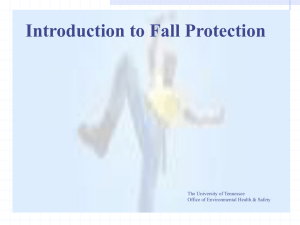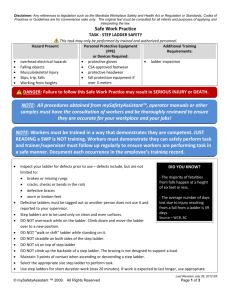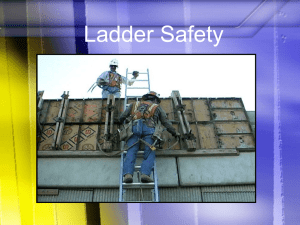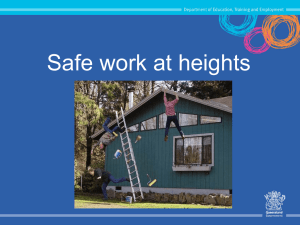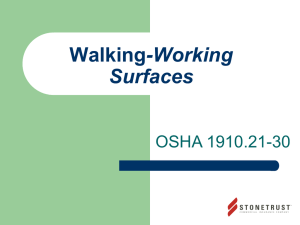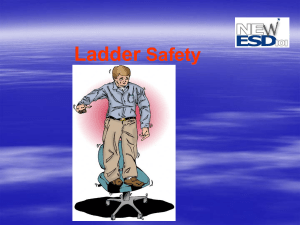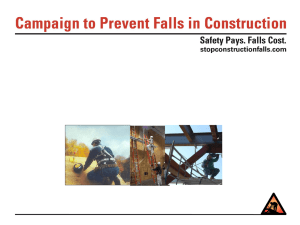General Safety Awareness Session for Volunteers
advertisement
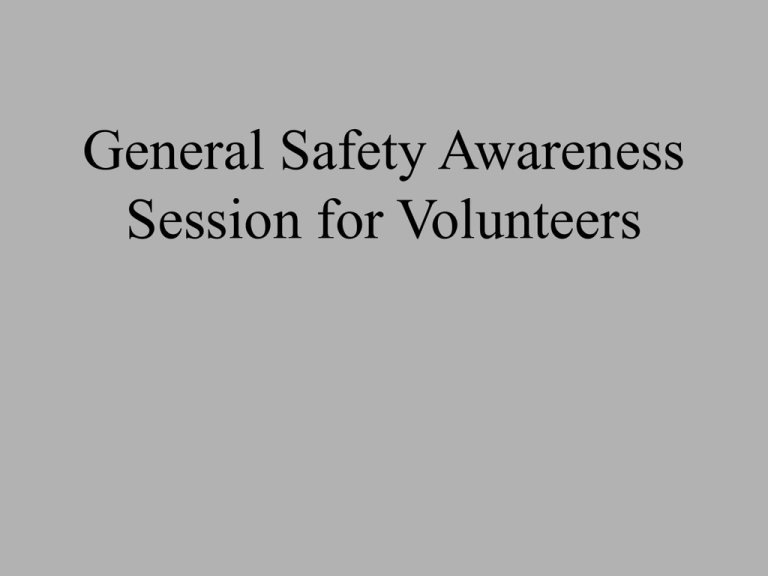
General Safety Awareness Session for Volunteers SHFH • We are committed to the safety of our staff and volunteers. This general safety awareness training will provide you with valuable information. If at any time you are uncomfortable with any task you are being asked to do, stop, think, and ask the site foreman… we will deploy you to another needed task. “Safety” is not an adjective to describe something or someone, it is a NOUN to us, a subject matter on its own. Personal Protective Equipment Examples of PPE Body Part Protection Eye Face Head safety glasses, goggles face shields hard hats Feet safety shoes Hands and arms gloves Bodies vests Hearing earplugs, earmuffs PPE Program • Includes procedures for selecting, providing and using PPE • First -- assess the workplace to determine if hazards are present, or are likely to be present, which necessitate the use of PPE • After selecting PPE, provide training to employees who are required to use it Training If employees are required to use PPE, train them: • • • • • • • Why it is necessary How it will protect them What are its limitations When and how to wear How to identify signs of wear How to clean and disinfect What is its useful life & how is it disposed When must Eye Protection be Provided? When any of these hazards are present: • Dust and other flying particles, such as metal shavings or sawdust • Corrosive gases, vapors, and liquids • Molten metal that may splash • Potentially infectious materials such as blood or hazardous liquid chemicals that may splash • Intense light from welding and lasers Safety Glasses • Made with metal/plastic safety frames • Most operations require side shields • Used for moderate impact from particles produced by jobs such as carpentry, woodworking, grinding, and scaling Face Shields • Full face protection • Protects face from dusts and splashes or sprays of hazardous liquids • Does not protect from impact hazards • Wear safety glasses or goggles underneath When Must Hearing Protection be Provided? After implementing engineering and work practice controls When an employee’s noise exposure exceeds an 8-hour time-weighted average (TWA) sound level of 90 dBA Examples of Hearing Protectors Earmuffs Earplugs Canal Caps Safety Shoes • Impact-resistant toes and heatresistant soles protect against hot surfaces common in roofing and paving • Some have metal insoles to protect against puncture wounds • May be electrically conductive for use in explosive atmospheres, or nonconductive to protect from workplace electrical hazards When Must Hand Protection be Provided? When any of these are present: • • • • • • • • Burns Bruises Abrasions Cuts Punctures Fractures Amputations Chemical Exposures Tools – Hand and Power Hazards • Workers using hand and power tools may be exposed to these hazards: objects that fall, fly, are abrasive, or splash harmful dusts, fumes, mists, vapors, and gases frayed or damaged electrical cords, and improper grounding Basic Tool Safety Rules • • • • Maintain regularly Use right tool for the job Inspect before use Operate according to manufacturers’ instructions • Use the right personal protective equipment (PPE) Use guards Hand Tool Hazards • Do not use: wrenches when jaws are sprung impact tools (chisels and wedges) when heads have mushroomed tools with loose, cracked or splintered handles a screwdriver as a chisel tools with taped handles – they may be hiding cracks Crack Power Tools • Must be fitted with guards and safety switches • Extremely hazardous when used improperly • Different types,determined by their power source: Electric Pneumatic Liquid fuel Hydraulic Precautions • Disconnect tools when not in use, before servicing and cleaning, and when changing accessories • Keep people not involved with the work away from the work • Secure work with clamps or a vise, freeing both hands to operate the tool • Keep tools sharp and clean • Consider what you wear – loose clothing and jewelry can get caught in moving parts • Remove damaged electric tools & tag them: “Do Not Use” Power Tools – Precautions Electric Cords • Don’t carry portable tools by the cord • Don’t use electric cords to hoist or lower tools • Don’t yank cord or hose to disconnect • Keep cords and hoses away from heat, oil, and sharp edges Electric Tools – Good Practices • Operate within design limits • Use gloves and safety shoes • Store in a dry place • Don’t use in wet locations unless approved for that • Keep work areas well lit • Ensure cords don’t present a tripping hazard Abrasive Wheels and Tools • May throw off flying fragments • Equip with guards that: Cover the spindle end, nut, & flange projections Maintain proper alignment with the wheel Don’t exceed the strength of the fastenings Radial Saw Guarding Radial arm saw equipped with an upper and lower blade guard Guard to prevent the operator from coming in contact the the rotating blade Pneumatic Tools • Powered by compressed air • Includes nailers, staplers, chippers, drills & sanders • Main hazard - getting hit by a tool attachment or by a fastener the worker is using with the tool Nail Gun Cut-Away View Ladders General Ladder Requirements Ladders must be kept in a safe condition -- DO – Keep the area around the top and bottom of a ladder clear Ensure rungs, cleats, and steps are level and uniformly spaced Ensure rungs are spaced 10 to 14 inches apart Keep ladders free from slipping hazards Securing Ladders • Secure ladders to prevent accidental movement due to workplace activity • Only use ladders on stable and level surfaces, unless secured • Do not use ladders on slippery surfaces unless secured or provided with slip-resistant feet This ladder is not on a stable surface Ladder Angle Non-self-supporting ladders: (which lean against a wall or other support) Position at an angle where the horizontal distance from the top support to the foot of the ladder is 1/4 the working length of the ladder Ladder Rail Extension When using a portable ladder for access to an upper landing surface, the side rails must extend at least 3 feet above the upper landing surface Crossbracing On this ladder the back rungs are designed for use Don’t use crossbracing on the rear of a stepladder for climbing - unless the ladder is designed for that Climbing the Ladder Face the ladder when going up or down Use at least one hand to grab the ladder when going up or down: 3 point connection or Fall protection Do not carry any object or load that could cause you to lose balance Fall Protection Fall Protection Options Personal Fall Arrest System (PFAS) Guardrails Safety Net Guardrails Top Rail Mid- Rail Toeboard • Top rails between 39 and 45 inches tall • Toeboards at least 3 1/2 inches high Fall Protection Residential Construction In residential construction, you must be protected if you can fall more than 6 feet Roofs If you work on roofs and can fall more than 6 feet, you must be protected Good Work Practices • Perform work at ground level if possible Example: building prefab roofs on the ground and lifting into place • Tether or restrain workers so they can't reach the edge • Designate and use safety monitors (This is less desirable of all the systems) • Use conventional fall protection • Limitations of Non conventional FP Thank You For Your Attention Be Sure To Sign In Documenting Your Attendance





